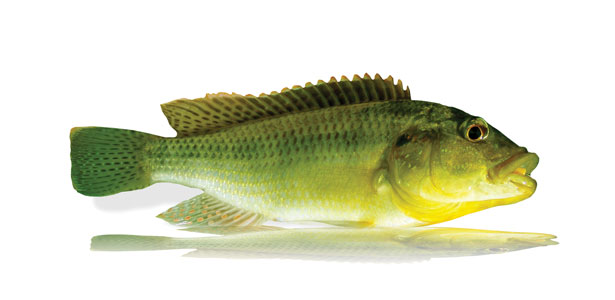
The Canary Kurper, commonly referred to as the “Kerriebek” among artlure anglers, is a species that bass will eat not only because of hunger but also out of pure aggression. It is endemic to the Limpopo River system and tributaries in Gauteng, the North West and Zimbabwe. It is regarded mostly as a pest fish. The Canary Kurper, like the Dwarf Kurper, is part of the cichlid family but only occurs in the areas surrounding the Limpopo system. Even though it is not widely distributed Canary Kurpers are very dominant in the water they occur in and very quickly take over if introduced to new waters. A very good example of this is Rust de Winter dam. Canary Kurper were never present in this dam but in a very short period have become one of the most abundant species in the dam.Canary Kurper is a highly popular angling species among beginner and especially young anglers as they are very aggressive and easy to catch. Using small grubs and spinners, one can easily catch a canary on every cast. They are also the ideal training species to teach kids how to fish with plastics.
Blue Kurper anglers see them as a nuisance and this species is probably responsible for more missed strikes by bass anglers than any other specie as they aggressively attack plastic lures, but their mouths are too small, in most cases, to become impaled on a bass hook. Even though the Canary Kurper is often caught in dams such as Roodeplaat, Rust de Winter, Hartbeespoort, RoodeKoppies, Vaalkop, Rietvlei, bass anglers know very little about them. The artlure fraternity target them as an angling species and catches are made using small grubs and spinners. This article provides some insight into the behaviour of this extremely aggressive bait fish specie.
Description
They are olive brown and green in colour; sexually mature Canary males have a brightly coloured chest, normally bright yellow. They have a distinctive marking of orange or red egg spots in the anal fin.They have a relatively slender body, big head, round tail and don’t have spiky fins like the tilapia species. Juvenile and female Canary Kurper are dull and greenish grey in colour and a lot smaller than the males. When looking at the male Canary in the water, the yellow chest shining brightly is very noticable. This is a real trigger for bass
Food source
They are extremely aggressive fish that prey on other fish species (including their own fry), larger crustaceans like shrimp and small crab, water and terrestrial insects, tadpoles etc. In fact, their behaviour as a predator is similar to that of bass, and there is very little difference between juvenile bass and canary kurper in terms of what they eat and how they hunt. An interesting thing for the bass angler to remember is that when canaries are aggressively attacking your plastic lures, conditions are favourable for bass fishing; you just have to find the bass. It seems like the same conditions that trigger canaries to feed also trigger bass.
Size
The males are much larger than the females and can grow to 20 cm in ideal conditions. The average size of male canaries that are sexually active is around 12 cm (5 inches).
Habitat
They relate to and live on the bottom or mid waters of a dam, feeding on free swimming organisms. They are comfortable in freshwater and brackish water. They prefer standing or slow-flowing water and thrive in impounded waters (dams). They occur in a wide variety of habitats, basically following, like bass, their food source. They will relate to any kind of structure attracting juvenile fish. Just like bass they flourish in areas with vegetation, trees, lay downs, man made structures, launch ramps, humps and drop offs. They do need a hard bottom for breeding but are much less specific than, for instance, the dwarf kurper. You will do well imitating a canary on any of your favourite structures in bass dams where they occur. They normally hunt in schools and can be easily spotted in clear water. In the afternoon in the heat of summer one can often spot them swimming near the surface in large schools causing ripples on the water. They also adapt well to deep water and have also been caught in the middle of winter in 60 foot of water in Hartbeespoort Dam.
Breeding Habits
Being part of the cichlid family, like the Dwarf Kurper, they are mouth brooders and the survival rate of the young is very high. They therefore quickly over populate in dams. The only predators that can control their numbers are bass. After the eggs have been fertilised, the female takes them in her mouth and incubation takes 18 to 21 days. After they hatch she will still harbour and look after them for another 3 to 4 weeks, after which the whole process is repeated. They breed from spring to autumn and some females go through this process 6 times during this period. It is however not the females or hatchlings we want to imitate, but the breeding sexually active males. They are aggressive and defend their territory. Their bright yellow breast area attracts the females, but is also easy for predators like bass to notice. They will move around relating the bottom and then attack intruders when they get too close.
Recent Research Findings
Bass and Canary Kurper are involved in a continuous survival struggle. Bass struggle to breed successfully in a dam with a large population of canaries, because schools of canaries will work together and while the bass chase one group away from the nest another group will attack the nest and devour the eggs. Bass fry are also targeted by shoals of canaries and very few make it to a size where they are not threatened by the canaries. Bass will never over populate in a dam with big canary stocks. When the bass however reach a certain size, the situation reverses and the bass have more food than what they could ever consume. Bass are, apart from birds, the only predators that can provide some sort of control over canary populations. Canaries are the main reasons for the low numbers of bass in Hartbeespoort Dam, but are also the main reason why the bass that are there are so strong, healthy and well conditioned. In fact, I have often wondered whether the yellow colour of bass in Harties is because they eat so many canaries! Studying bass and canaries together in a lab environment proved without a doubt that bass hate canaries, especially the bright yellow males. Bass enjoy canaries as a food source, but even when full they would attack and kill the male canary and spit it out again. It seems like the ordeal the male bass goes through in the spawn is remembered and he takes his revenge when the opportunity arises!
Conclusions
When fishing bass structure in a dam where Canary Kurper are present, fish in a manner designed to aggravate the bass in the area. Fish slowly on the bottom and now and again deliver a fast darting movement as if the bait is chasing something. If a bass suddenly sees a yellow breasted baitfish moving towards him it is going to smash it, whether he is hungry or not! Fish canary imitations weightless near the surface in the afternoon in summer in areas where you spot schools of canaries.
Remember – a smaller bass is not very fussy, but if you want to trigger a big bite consistently, do everything you can to put the odds in your favour. Don’t only match the hatch with the bait you choose but also by the way you fish.


 Visit us our
Visit us our